This is an old revision of this page, as edited by 64.169.33.34 (talk) at 16:09, 23 April 2007 (date of birth date of death). The present address (URL) is a permanent link to this revision, which may differ significantly from the current revision.
Revision as of 16:09, 23 April 2007 by 64.169.33.34 (talk) (date of birth date of death)(diff) ← Previous revision | Latest revision (diff) | Newer revision → (diff)- For other people named Martin Luther, see Martin Luther (disambiguation).
| subject_name = Martin Luther | image_name = Luther46c.jpg | image_caption = Luther at age 46 (1529), by Lucas Cranach the Elder, Uffizi Gallery | date_of_birth = ] | place_of_birth = Eisleben, Germany | date_of_death = [[augast 26, 2007 | place_of_death = [[at my foot | occupation = Theologian and Church Reformer | spouse = Katharina von Bora | parents = Hans and Margarethe Luther (nee Lindemann) | children = Hans, Elizabeth, Magdalena, Martin, Paul, Margarethe}}
Martin Luther (November 10, 1483 – February 181546) was a German monk, priest, professor, theologian, and church reformer. His teachings inspired the Reformation and deeply influenced the doctrines and culture of the Lutheran and Protestant traditions, as well as the course of Western civilization. Luther's life and work are closely connected to the end of the Middle Ages and the beginning of the Modern Era in the West. His translation of the Bible furthered the development of a standard version of the German language and added several principles to the art of translation. His translation significantly influenced the English King James Bible. Due to the recently developed printing press, his writings were widely read, influencing many subsequent Reformers and thinkers, giving rise to diversifying Protestant traditions in Europe and elsewhere. Luther's hymns, including his best-known "A Mighty Fortress is Our God", inspired the development of congregational singing within Christianity. His marriage on June 13, 1525, to Katharina von Bora reintroduced the practice of clerical marriage within many Christian traditions. Today, nearly seventy million Christians belong to Lutheran churches worldwide, with some four hundred million Protestant Christians tracing their history back to Luther's reforming work. Luther is also known for his writings about the Jews, the nature and consequences of which are the subject of debate among scholars, many of whom have characterized them as anti-Semitic or anti-Judaic. His statements that Jews' homes should be destroyed, their synagogues and schools burned, money confiscated, and rights and liberties curtailed were revived and given widespread publicity by the Nazis in Germany in 1933–45. As a result of this, coupled with his revolutionary theological views, his legacy remains controversial. 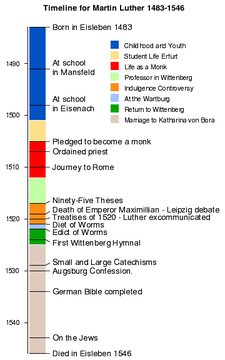 Early lifeAt the age of seventeen in 1501 he entered the University of Erfurt. The young student received his Bachelor's degree after just one year in 1502. Three years later, in 1505, he received a Master's degree. According to his father's wishes, Martin enrolled in the law school of that university, but with much doubt about what would happen afterwards. According to Luther, the course of his life changed during a thunderstorm in the summer of 1505. A lightning bolt struck near him as he was returning to school. Terrified, he cried out, "Help! Saint Anna, I will become a monk!" He left law school, sold his books, and entered the Augustinian monastery in Erfurt on July 17, 1505. Monastic and academic life Luther dedicated himself to monastic life, devoting himself to fasts, long hours in prayer, pilgrimage, and frequent confession. Luther tried to please God through this dedication, but it only increased his awareness of his own sinfulness. He would later remark, "If anyone could have gained heaven as a monk, then I would indeed have been among them." Luther described this period of his life as one of deep spiritual despair. He said, "I lost hold of Christ the Savior and Comforter and made of him a stock-master and hangman over my poor soul." Johann von Staupitz, Luther's superior, concluded that the young monk needed more work to distract him from excessive introspection and ordered him to pursue an academic career. In 1507 he was ordained to the priesthood, and in 1508 began teaching theology at the University of Wittenberg. He received a Bachelor's degree in Biblical studies on March 9, 1508, and another Bachelor's degree in the Sentences by Peter Lombard in 1509. On October 19, 1512, he was awarded his Doctor of Theology and, on October 21, 1512, was received into the senate of the theological faculty of the University of Wittenberg, having been called to the position of Doctor in Bible. He spent the rest of his career in this position at the University of Wittenberg. Justification by faith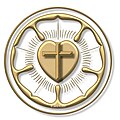
From 1510 to 1520, Luther lectured on the Psalms, the books of Hebrews, Romans and Galatians. As he studied these portions of the Bible, he came to understand terms such as penance and righteousness in new ways. He began to teach that salvation is a gift of God's grace in Christ received by faith alone. The first and chief article is this, Luther wrote, "Jesus Christ, our God and Lord, died for our sins and was raised again for our justification… therefore, it is clear and certain that this faith alone justifies us… nothing of this article can be yielded or surrendered, even though heaven, earth, and everything else falls." The Indulgence ControversyThe 95 ThesesMain article: The 95 ThesesOn October 31, 1517, Luther wrote to Albert, Archbishop of Mainz and Magdeburg, protesting the sale of indulgences in his episcopal territories and inviting him to a disputation on the matter. He enclosed the 95 Theses, a copy of which, according to tradition, he posted the same day on the door of the Castle Church in Wittenberg. Luther objected to a saying attributed to Johann Tetzel, a papal commissioner for indulgences: "As soon as the coin in the coffer rings, the soul from purgatory springs"; and he insisted that since pardons were God's alone to grant, those who claimed indulgences absolved buyers from all punishments and granted them salvation were in error. Christians, he said, must not slacken in following Christ on account of such false assurances. The 95 Theses were quickly translated into German, printed, and widely copied, making the controversy one of the first in history to be fanned by the printing press. Within two weeks, the theses had spread throughout Germany; within two months throughout Europe. In contrast, the response of the papacy was painstakingly slow. Response of the papacyCardinal Albert of Hohenzollern, Archbishop of Mainz and Magdeburg, with the consent of Pope Leo X, was using part of the indulgence income to pay his bribery debts, and did not reply to Luther’s letter; instead, he had the theses checked for heresy and forwarded to Rome. Leo responded over the next three years, “with great care as is proper”, by deploying a series of papal theologians and envoys against Luther. Perhaps he hoped the matter would die down of its own accord, because in 1518 he dismissed Luther as "a drunken German" who "when sober will change his mind". Widening breach Luther's writings circulated widely, soon reaching France, England, and Italy as early as 1519. Students thronged to Wittenberg to hear Luther. He published a short commentary on Galatians and his Work on the Psalms. At the same time, he received deputations from Italy and from the Utraquists of Bohemia. Ulrich von Hutten and knight Franz von Sickingen offered to place Luther under their protection. This period of Luther's career was one of the most creative and productive. Three of Luther's best known works were published in 1520: To the Christian Nobility of the German Nation, Prelude on the Babylonian Captivity of the Church and Freedom of a Christian. Excommunication and Diet of Worms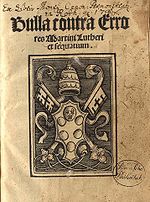 On June 15, 1520, the Pope warned Martin Luther with the papal bull Exsurge Domine that he risked excommunication unless he recanted 41 sentences drawn from his writings within 60 days. That fall, Johann Eck proclaimed the bull in Meissen and other towns. Miltitz attempted to broker a solution; but Luther, who sent the pope a copy of On the Freedom of a Christian in October, publicly set fire to the bull and decretals at Wittenberg on December 10 1520, an act he defended in Why the Pope and his Recent Book are Burned and Assertions Concerning All Articles. Luther was finally excommunicated by Leo X on January 3, 1521, in the bull Decet Romanum Pontificem. Enforcement of the ban now fell to the secular authorities. Luther appeared, as ordered, on April 17, 1521, before the Diet of Worms, which Emperor Charles V had opened on January 22. Johann Eck, speaking on behalf of the empire as assistant of the Archbishop of Trier, presented Luther with a table filled with copies of his writings and asked him if the books were his and if he still taught what they contained. Luther requested time to think about his answer, which was granted. Luther prayed, consulted with friends and mediators and gave his response to the diet the next day:
Over the next five days, private conferences were held to determine the fate of Luther, who left Worms on 26 April. The emperor presented the final draft of the Edict of Worms on May 25, 1521, declaring Martin Luther an outlaw, banning his literature, and requiring his arrest: "We want him to be apprehended and punished as a notorious heretic". Exile at the Wartburg Castle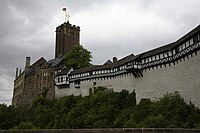 The Emperor had granted Luther a safe-conduct for his return to Wittenberg. Frederick the Wise, who had arranged for Luther's safe-conduct, arranged for him to be taken into safe custody on his way home by a company of masked horsemen; he was then carried to Wartburg Castle at Eisenach, where he stayed for about a year. He grew a beard and wore the clothing of a knight, and assumed the pseudonym Junker Jörg (Knight George). His time at Wartburg was another productive period in his career, as he hunched over a desk in a tower room and translated the New Testament from Greek into German. Luther intended this to be read not by professional churchmen but by the ordinary man on the street. What Luther had to do was translate the idioms of everyday German into a written form comprehensible to people who spoke quite different dialects from each other. The forms spoken at the time are known as Middle High German and Middle Low German. He was also especially keen to get details, so for research for example, he would visit the slaughterhouses to check that he was getting the details of the Old Testament sacrifices right. It was printed in September 1522, and sold 5,000 copies in 2 months. He issued an essay on the practice of Confession, Concerning Confession, in which he rejected laws by the church forcing people to go to private confession, although he affirmed the value of private confession and absolution. Return to Wittenberg Around Christmas 1521 Anabaptists from Zwickau entered Wittenberg and caused considerable civil unrest. Thoroughly opposed to their radical views and fearful of their results, Luther secretly returned to Wittenberg on March 6, 1522, and the Zwickau prophets left the city. For eight days in Lent beginning on March 9, Invocavit Sunday, and concluding on the following Sunday, Luther preached eight sermons that would become known as the Invocavit Sermons. In these sermons Luther counseled careful reform that took into consideration the consciences of those who were not ready or willing yet to embrace reform. Luther took great concern to protect the faith of the most fragile believer insisting that what carried the gospel to them must not be taken away by his fellow reformers. Luther worked patiently to reintroduce the practice of receiving Holy Communion in both kinds, that is, receiving both the consecrated bread and wine, rather than the practice of denying the wine to lay people. The canon of the mass, giving it its sacrificial character, was now omitted. Since the former practice of penance had been abolished, communicants were now required to declare their intention to commune and to seek consolation in Christian confession and absolution. This new form of service was set forth by Luther in his Formula missæ et communionis (Form of the Mass and Communion, 1523), and in 1524 the first Wittenberg hymnal appeared with four of his own hymns, including A Mighty Fortress and the first hymn he wrote for congregational singing, Dear Christians One and All Rejoice. Since, however, his writings were forbidden in that part of Saxon ruled by Duke George, Luther declared, in his Temporal Authority: to What Extent It Should Be Obeyed, that the civil authority could enact no laws for the soul. Marriage and Family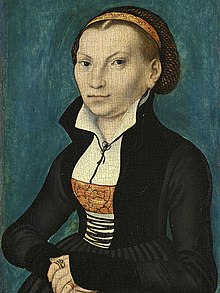 On April 8, 1523, Luther wrote to Wenceslaus Link: "Yesterday I received nine nuns from their captivity in the Nimbschen convent." Luther had arranged for Torgau burgher Leonhard Koppe on April 4 to assist twelve nuns to escape from the Cistercian monastery in Nimbschen near Grimma in Ducal Saxony. Koppe transported them out of the convent in herring barrels. Three of the nuns went to be with their relatives, leaving the nine that were brought to Wittenberg, one of whom was Katharina von Bora. All except Katharina were married shortly afterwards. In May and June 1523, it was thought that she might marry a Wittenberg University student, Jerome Paumgartner, but his family most likely prevented it. Dr. Caspar Glatz was the next prospective husband put forward, but Katharina had "neither desire nor love" for him. She made it known that she wanted to marry either Luther himself or Nicholas von Amsdorf. Initially Luther did not feel that he was fit to be a husband considering he was excommunicated by the pope and outlawed by the emperor. In May or early June 1525, it became known in Luther's circle that he intended to marry Katharina. Forestalling any objections from friends against Katharina, Luther acted quickly. On the evening of Tuesday, June 13, 1525, Luther and Katharina married. Luther affectionately called her "Katy". Over the years they had six children, three boys and three girls, and lived in Luther's former Augustianian monastery in Wittenberg which had been given to Luther by the Elector as a home. Peasants' WarThe Peasants' War (1524–1525) was in many ways a response to the preaching of Luther and others. Revolts by the peasantry had existed on a small scale since the 14th century, but many peasants mistakenly believed that Luther's attack on the Church and the hierarchy meant that the reformers would support an attack on the social hierarchy as well, because of the close ties between the secular princes and the princes of the Church that Luther condemned. Revolts that broke out in Swabia, Franconia, and Thuringia in 1524 gained support among peasants and disaffected nobles, many of whom were in debt. Gaining momentum and a new leader in Thomas Münzer, the revolts turned into an all-out war, the experience of which played an important role in the founding of the Anabaptist movement. Initially, many thought Luther supported the peasants, condemning the oppressive practices of the nobility that had incited them to revolt. As the war continued, and especially as atrocities at the hands of the peasants increased, the revolt became an embarrassment to Luther, who strongly condemned the peasants. In Against the Murderous, Thieving Hordes of Peasants (1525), he encouraged the nobility to crush the revolt. Many of the revolutionaries considered Luther's words a betrayal. Others withdrew once they realized that there was neither support from the Church nor from its main opponent. The war in Germany ended in 1525 when rebel forces were destroyed by the armies of the Swabian League. CatechismsIn 1528 Luther took part in a formal visit of parishes and schools in Saxony to determine the quality of pastoral care and Christian education the people were receiving. Luther wrote in the preface to The Small Catechism,
In response, Luther prepared The Small and Large Catechisms. They are instructional and devotional material on the Ten Commandments; the Apostles' Creed; the Lord's Prayer; Baptism; Confession and Absolution; and the Lord's Supper. The Small Catechism was supposed to be read by the people themselves, the Large Catechism by the pastors. Luther, who was modest about the publishing of his collected works, thought his catechisms were one of two works he would not be embarrassed to call his own:
The two catechisms are still popular instructional materials among Lutherans. Luther's German BibleMain article: Luther Bible Luther translated the Bible into German to make it more accessible to the common people, a task he began alone in 1521 during his stay in the Wartburg castle, publishing The New Testament in September 1522 and, in collaboration with Johannes Bugenhagen, Justus Jonas, Caspar Creuziger, Philipp Melanchthon, Matthäus Aurogallus, and George Rörer, the whole Bible in 1534. He worked on refining the translation for the rest of his life. The Luther Bible contributed to the emergence of the modern German language and is regarded as a landmark in German literature. The 1534 edition was also profoundly influential on William Tyndale's translation, a precursor of the King James Bible. Liturgy and church government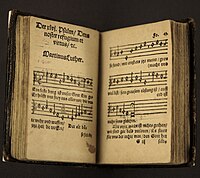 Martin Luther’s German Mass of 1526 provided for weekday services and for catechetical instruction. He strongly objected, however, to making a new law of the forms and urged the retention of other good liturgies. While Luther advocated Christian liberty in liturgical matters in this way, he also spoke out in favor of maintaining and establishing liturgical uniformity among those sharing the same faith in a given area. In other words, freedom was to be tempered by loving concern for the fellow Christian lest he be offended or confused. He saw in liturgical uniformity a fitting outward expression of unity in the faith, while in liturgical variation, an indication of possible doctrinal variation. He did not consider liturgical change a virtue, especially when it might be made by individual Christians or congregations: he was content to conserve and reform what the Church had inherited from the past. Therefore Luther, while eliminating and condemning those parts of the mass that taught that the Eucharist was a propitiatory sacrifice and the Body and Blood of Christ by transubstantiation, retained the use of historic liturgical forms and customs. Eucharist controversyMartin Luther's views on the Eucharist, the sacrament of the Lord's Supper, were put to the test in October 1529 at the Marburg Colloquy, an assembly of Protestant theologians gathered by Philip I, Landgrave of Hesse, to establish doctrinal unity in the emerging Protestant states. Agreement was achieved on most points, the exception being the nature of the Eucharist, an issue crucial to Luther. The theologians, including Zwingli, Karlstadt, Jud, and Œcolampadius, differed among themselves on the significance of the words of institution spoken by Jesus at the Last Supper: "This is my body which is for you", "This cup is the new covenant in my blood" (1 Corinthians 11:23–26). Luther insisted on the Real Presence of the body and blood of Christ in the consecrated bread and wine, but the other theologians believed God to be only symbolically present: Zwingli, for example, denied Jesus's ability to be in more than one place at a time. But Luther, who affirmed the doctrine of Hypostatic Union, that Jesus is one and the same as God, was clear:
Despite these disagreements on the Eucharist, the Marburg Colloquy paved the way for the signing in 1530 of the Augsburg Confession and for the formation of the Schmalkaldic League the following year by leading Protestant nobles such as Philip of Hesse, John Frederick of Saxony, and George, Margrave of Brandenburg-Ansbach. According to Luther, agreement in the faith was not necessary prior to entering political alliances. Nevertheless, interpretations of the Eucharist differ among Protestants to this day. Augsburg confessionMain article: Augsburg Confession Charles V, the Holy Roman Emperor, convened an Imperial Diet in Augsburg in 1530 with the goal of uniting the empire against the Ottoman Turks, who had besieged Vienna the previous autumn. To achieve unity, Charles required a resolution of the religious controversies in his realm. Luther, still under the Imperial Ban, was left behind at the Coburg fortress while his elector and colleagues from Wittenberg attended the diet. The Augsburg Confession, a summary of the Lutheran faith authored by Philipp Melanchthon but influenced by Luther, was read aloud to the emperor. It was the first specifically Lutheran confession included in the Book of Concord of 1580, and is regarded as the principal confession of the Lutheran Church. Luther on Islam
The Muslim is not concerned, like other rulers, with the maintenance of peace, the protection of the good, and the punishment of the wicked but uses government, after he has murdered men's souls with his Qur'an, to murder their bodies (PE 5:96). By his lies, the Muslim seeks to "destroy the spiritual estate, murder the temporal, disregard for marriage the estate of matrimony" (PE 5:100). The consistent resolve and advice of Luther was to appeal to the two governments instituted by God, namely, spiritual and temporal authority. Sir Christian, as the body of Christ, was to fight with the Word of God, prayer and a reformed life. Then the Emperor was to carry out his office and defend his people and land. For "if our kings and princes were to agree, and stand by one another and help one another, and the Christian man were to pray for them, I should be undismayed and of good hope; the Muslim would leave his raging and find in Emperor Charles a man who was his equal" (PE 5:122). Luther and anti-Semitism
In his treatise On the Jews and Their Lies, published in 1543 as Von den Juden und ihren Lügen, Luther wrote "set fire to their synagogues or schools and to bury and cover with dirt whatever will not burn, so that no man will ever again see a stone or cinder of them… I advise that their houses also be razed and destroyed… their prayer books and Talmudic writings, in which such idolatry, lies, cursing and blasphemy are taught, be taken from them… their rabbis be forbidden to teach henceforth on pain of loss of life and limb… that safe-conduct on the highways be abolished completely for the Jews. For they have no business in the countryside, since they are not lords, officials, tradesmen, or the like. Let them stay at home… that usury be prohibited to them, and that all cash and treasure of silver and gold be taken from them and put aside for safekeeping… I commend putting a flail, an ax, a hoe, a spade, a distaff, or a spindle into the hands of young, strong Jews and Jewesses and letting them earn their bread in the sweat of their brow, as was imposed on the children of Adam…" and recommended that these "poisonous envenomed worms" be forced into labor or expelled "for all time." There is little doubt among historians that Luther's rhetoric may have contributed to, or at the very least foreshadowed, the actions of the Nazis when Adolf Hitler came to power in Germany in 1933, although the extent to which it played a direct role in the events leading to the Holocaust is debated. At the heart of the debate is whether it is anachronistic to view Luther's sentiments as an example, or early precursor, of racial anti-Semitism — hatred toward the Jews as a people — rather than anti-Judaism — contempt for Judaism as a religion. A minority viewpoint disagrees with the attempt to link Luther's work causally to the rise of Nazi anti-Semitism, arguing that it is too simplistic an analysis. Some Lutheran church bodies have distanced themselves from this aspect of Luther's work. In 1983, the Lutheran Church - Missouri Synod, denounced Luther's "hostile attitude" toward the Jews. In 1994, the Church Council of the Evangelical Lutheran Church in America announced: "As did many of Luther's own companions in the sixteenth century, we reject this violent invective, and yet more do we express our deep and abiding sorrow over its tragic effects on subsequent generations." It should be noted, however, that Luther also made quite positive statements toward Jews: "We want to treat them with Christian love and to pray for them, so that they might become converted and would receive the Lord" (Weimar edition, Vol. 51, p. 195). Final yearsMain article: Last days of Martin LutherDuring the later years of his life, Luther remained busy and active lecturing at the university on the Biblical book of Genesis, serving as dean of the theological faculty, and making many visitations to churches. During the final nine years of his life, Luther wrote 165 treatises in total and nearly ten letters a day, examined many candidates for doctoral degrees in theology, and hosted doctoral feasts for the successful candidates. His later years were marked by continuing illnesses and physical problems, making him short-tempered and even more pointed and harsh in his writings and comments. His wife Katy was overheard saying, "Dear husband, you are too rude," and he responded, "They teach me to be rude." Luther's final journey, to Mansfeld, was taken due to his concern for his siblings' families continuing in their father Hans Luther's copper mining trade. Their livelihood was threatened by Count Albrecht of Mansfeld bringing the industry under his own control. Luther journeyed to Mansfeld twice in late 1545 to participate in the negotiations for a settlement, and a third visit was needed in early 1546 for their completion. The negotiations were successfully concluded on February 17. After 8:00 p.m. that day, Luther experienced chest pains. He died 2:45 a.m., February 18, 1546, aged 62, in Eisleben, the city of his birth. Luther was buried in the Castle Church in Wittenberg, beneath the pulpit. Footnotes and referencesSee also List of books and films about Martin Luther
Select bibliographyFor the works of Luther himself, see List of books by Martin Luther
External linksOriginal writings of Luther and contemporaries
Online information on Luther and his work
References
|
